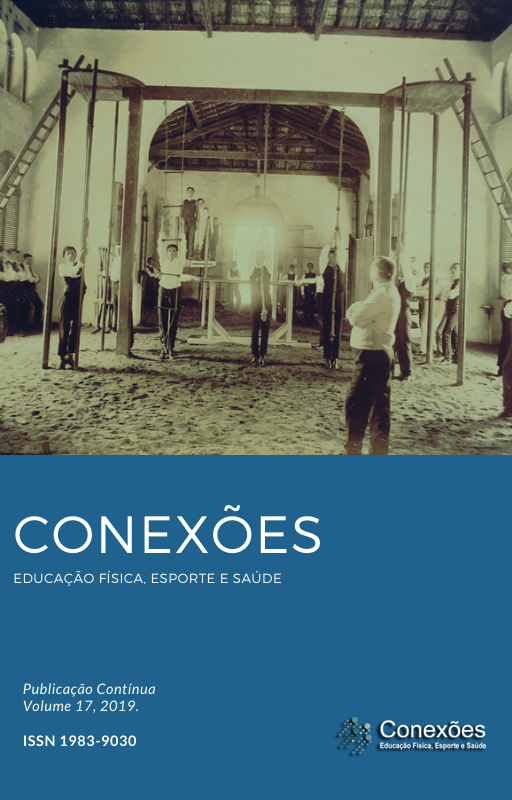Abstract
Introduction: Postural control is an essential motor component for paracanoe performance. However, the protocols commonly used to evaluate this variable have high cost, difficulty of application in field environment and difficult operationalization. Objective: to analyze the applicability of inertial sensors present in smartphones to measure postural control in paracanoe. Method: The sample consisted of 6 male paracanoe practitioners with motor disability and an age range of 31.3±7.1 years. The experimental protocol consisted of attaching a smartphone to the vessel and the Sensor Kinects Pro app was used to measure the values of the gyroscope to record the angular displacements in two conditions: 1) with the hands supporting the lower limbs and 2) with the hands holding a canoeing row. Results and discussion: The results showed high rotation values according to motor impairment, with an increase in rotation values in all deficiency classifications of the sample when submitted to the position without support of the upper limbs. Conclusion: Cell phone sensors had discriminatory power to identify differences in angular displacement of the X-axis in different conditions and functional classifications of paracanoe.
References
CAMOMILLA, Valentina; BERGAMINI, Elena; FANTOZZI, Silvia; VANNOZZI, Giuseppe. Trends supporting the in-field use of wearable inertial sensors for sport performance evaluation: a systematic review. Sensors, v. 18, n.3, p. 1-50, 2018. Disponível em: https://www.mdpi.com/1424-8220/18/3/873.
CHEN, Chiung-Ling; YEUNG, Kwok-Tak; BIH, Liu-Ing; WANG, Chun Hou; CHEN, Ming-L; CHIEN, Jung. Chung. The relationship between sitting stability and functional performance in patients with paraplegia. Arch Phys Med Rehabil, v. 84, n. 9, p. 1276-81, 2003. Disponível em: https://www.sciencedirect.com/science/article/abs/pii/S0003999303002004.
EDWARDS, John; BJERKEFORS, Anna; ROSEN, Johanna; TARASSORA, Olga. Paracanoe. Handbook Of Sports Medicine And Science, [s.l.], p.106-115, 18 jan. 2019. Disponível em: http://dx.doi.org/10.1002/9781119097198.ch9
ELLIS, Shelley; CALLAWAY, Andrew; DYER, Bryce. The influence of lowerlimb prostheses technology on Paracanoeing time-trial performance. Disability and Rehabilitation: Assistive Technology, v.13, n.6, p. 568-574, 2017. Disponível em: https://www.tandfonline.com/doi/abs/10.1080/17483107.2017.1357052
GRANGEON, Murielle; GAGNON, Dany; GAUTHIER, Cindy; JACQUEMIN, Géraldine; MASANI, Kei; POPOVIC, Milos R. Effects of upper limb positions and weight support roles on quasi-static seated postural stability in individuals with spinal cord injury. Gait & Posture, v. 36, n. 3, p. 572-579, jul. 2012. Disponível em: https://www.sciencedirect.com/science/article/abs/pii/S0966636212001658
GRIGORENKO, Anatoli; BJERKEFORS, Anna; ROSDAHL, Hans G.; HULTLING, Claes; ALM, Marie; THORSTENSSON, Alf. Sitting balance and effects of kayak training in paraplegics. Journal Of Rehabilitation Medicine, v. 36, n. 3, p. 110-116, 2004. Disponível em: https://www.semanticscholar.org/paper/Sitting-balance-and-effects-of-kayak-training-in-Grigorenko- Bjerkefors/2b823da0ccbaea6457029388d24b65f7b99447a2
HAMACHER, Daniel; KREBS, Tobias; MEYER, Guido; ZECH, Astrid. Does local dynamic stability of kayak paddling technique affect the sports performance? A pilot study. European Journal of Sport Science, v. 18, n. 4, p. 491–496, 2018. doi:10.1080/17461391.2018.1435726. Disponível em: https://www.tandfonline.com/doi/abs/10.1080/17461391.2018.1435726
HAN, Seulki; LEE, Daehee; LEE, Sangyong. A study on the reliability of measuring dynamic balance ability using a smartphone. Journal Of Physical Therapy Science, [s.l.], v. 28, n. 9, p. 2515-2518, 2016. Disponível em: https://www.jstage.jst.go.jp/article/jpts/28/9/28_jpts-2016-346/_article/-char/ja/.
HSIEH, Katherine L.; ROACH, Katlheen L.; WAJDA, Douglas A.; SOSNOFF, Jacob J. Smartphone technology can measure postural stability and discriminate fall risk in older adults. Gait & Posture, v. 67, p. 160-165, 2019. Disponível em: https://www.sciencedirect.com/science/article/abs/pii/S0966636218304521
JOHNSTON, William; O’REILLY, Martin; ARGENT, ROB; CAULFIELD, Brian. Reliability, Validity and Utility of Inertial Sensor Systems for Postural Control Assessment in Sport Science and Medicine Applications: A Systematic Review. Sports Medicine, v. 59, n. 5, p. 783-818, 2019. Disponível em: https://link.springer.com/article/10.1007%2Fs40279-019-01095-9
MAGNANINI, Angela. Inclusive sport possibilities: educational study on Paracanoe. Uluslararası Güncel Eğitim Araştırmaları Dergisi, v. 2, n. 1, p. 170-177, 2016. Disponível em: https://dergipark.org.tr/tr/pub/intjces/issue/25669/270738
MILOSEVIC, Matija; GAGNON Dany H.; GOURDOU, Philippe; NAKAZAWA, Kimitaka. Postural regulatory strategies during quiet sitting are affected in individuals with thoracic spinal cord injury. Gait & Posture, v. 58, p. 446-452, 2017. Disponível em: https://www.sciencedirect.com/science/article/abs/pii/S0966636217308883
MINKEL, Jean L. Seating and Mobility Considerations for People With Spinal Cord Injury. Physical Therapy, [s.l.], p. 701-709, 1 jul. 2000. Disponível em: https://academic.oup.com/ptj/article/80/7/701/2842522
PATTERSON, Jeremy, A.; AMICK, Ryan Z.; THUMMAR, Tarunkumar; ROGERS Michael E. Validation of measures from the smartphone sway balance application: a pilot study. The International Journal of Sports Physical Therapy, v. 9, n. 2, p. 135-139, 2014. Disponível em: https://www.ncbi.nlm.nih.gov/pmc/articles/PMC4004118/
PENSGAARD, Anne Marte; SORENSEN, Marit. Empowerment through the sport prostheses technology on Paracanoeing time-trial performance. Disability and Rehabilitation: Assistive Technology, v. 13, n. 6, p. 568-574, 2017. Disponível em: https://www.tandfonline.com/doi/abs/10.1080/17483107.2017.1357052
SHIN, Sunghoon; SOSNOFF, Jacob J. Spinal cord injury and time to instability in seated posture. Archives of Physical Medicine and Rehabilitation, 2013, v. 94, n. 8, p. 1615-1620. Disponível em: https://www.sciencedirect.com/science/article/abs/pii/S0003999313001330
THOMAS, Jerry R.; NELSON, Jack K.; SILVERMAN, Stephen J. Métodos de pesquisa em atividade física. 6. ed. Porto Alegre: Artmed, 2012.
The Conexões: Educação Física, Esporte e Saúde Journal uses the license of Creative Commons (CC), thus preserving the integrity of articles in an open access environment.


